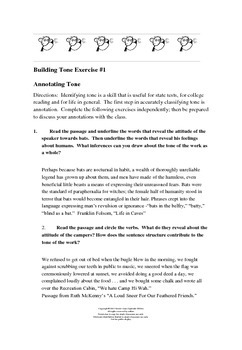Distance Learning - AP Lang Identifying Tone Exercises
- PDF
Also included in
- This product has EVERYTHING (23 products!) you need to introduce rhetoric to your AP Language or or older composition students!This bundle includes all my best selling activities for AP Lang including: Rhetorical Situation Learning Stations, Connotation and Denotation exercises, Meaning and Syntax,Price $105.99Original Price $114.02Save $8.03
Description
This 15 page resource WITH answer key is a highly effective means of teaching tone to advanced students. I use this with honors, AP and college students to build their skills through annotation and how to apply this knowledge to real rhetoric. There are two lengthy exercises. The first is annotation with 10 excerpts from various pieces of literature and non-fiction. The second offers eight close reading passages with application rewrites. Students develop skill and confidence through these activities. Each exercise is extremely versatile - both exercises can be completed through homework, partner work, or assessment. All examples are cited and a detailed answer key is provided.
Related Resources
How to Write for AP Lang Sophistication Point
Distance Learning Rhetorical Situation Podcast Project
Introduction to AP Lang Choice Board
Distance Learning: Rhetorical Questions You Should Ask Yourself Word Sort
Distance Learning - Using Music to Reinforce Rhetorical Analysis
Thank You for Arguing Infographic Project
Thank You for Arguing Test - Choice of TWO
Thank You For Arguing Assignments and Project
Distance Learning - AP Lang Twitter Hashtag Claim Analysis
AP Language and Rhetorical Situation Learning Stations
Writers on Twitter Rhetorical Analysis
How to Vary Your Syntax With Ease
AP Lang 6 point Synthesis Rubric Pre-Write and Peer Conference
AP Lang 6 point Argument Rubric with Peer Conference
AP Lang 6 point Rhetorical Analysis Rubric with Peer Conference and Self-Evaluation
Distance Learning 10 Top in the Last 10 Argument Pre-Write
AP Lang Verbs that Identify Author’s Purpose Word Sort
Embedding Quotes Model and Practice
AP Lang Bias and Rhetoric in Journalism
AP Lang Quiz Parallelism as Rhetoric
The Synthesis Process: College Level Writing
Connotation and Denotation Exercises
50 Ways to Make Your Writing Sound Smart
Dialectical Journal: A Student Guide
Toulmin Model of Argumentation Outline and Explanation
Want to learn more about SEL in high school? Join my mailing list!





